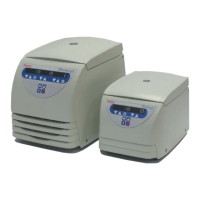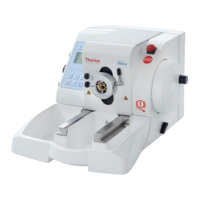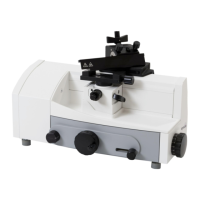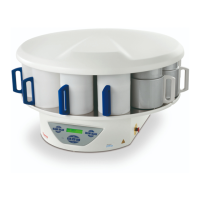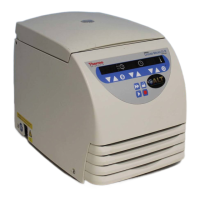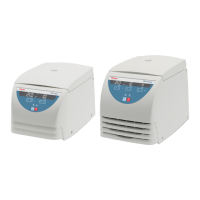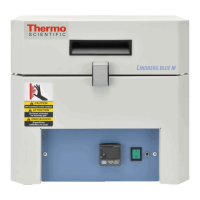Do you have a question about the Thermo Scientific MicroCL 17 and is the answer not in the manual?
Describes the displays on the control panel, including speed, time, and temperature.
Describes the function of each key on the control panel for operation.
Describes the switch functions for parameters like speed/RCF and pre-temperature.
Lists and explains error codes for instrument malfunctions and their meanings.
General safety warnings and explanation of symbols used in the manual.
Warning about potential hazards and the need to read the manual before operation.
Guidelines for correct centrifuge operation and sample density limits.
Warnings against incorrect handling and its potential consequences.
Safety precautions for handling hazardous, toxic, or radioactive substances.
Basic rules for handling the instrument safely, including accessories.
Information on compliance with relevant international safety standards.
Lists items included with the centrifuge upon purchase.
Details the built-in safety features integrated into the instrument.
Describes the general characteristics and operational features of the centrifuge.
Explanation of the quick run function for short-term centrifugation.
Criteria for selecting an appropriate and safe installation site for the centrifuge.
Instructions for safely moving and setting up the instrument.
Specific installation advice for models equipped with a refrigeration unit.
How to properly connect the centrifuge to the electrical power supply.
Steps to remove protective elements before initial operation.
Technical performance data for various rotors compatible with MicroCL 17.
Technical performance data for various rotors compatible with MicroCL 21.
Technical performance data for various rotors compatible with MicroCL 17R.
Technical performance data for various rotors compatible with MicroCL 21R.
Information and specifications for rotor adapters and reduction sleeves.
Specifies the permissible operating temperature range for rotors.
Advises on rotor inspection, care, and signs of wear or damage.
Describes the mechanism and procedure for opening the rotor lid.
Instructions for properly closing the rotor lid after loading.
Precautions and procedures when operating the rotor without its lid.
Details specific rotor lids that use a screw plug mechanism.
Safety measures and requirements for centrifuging hazardous samples.
Procedures for lubricating and correctly inserting rotor seals.
Method to test and verify the aerosol containment of the rotor.
Steps to power on the instrument and initial display checks.
How to open the centrifuge lid using the designated button.
Instructions for properly closing and locking the centrifuge lid.
Detailed procedure for correctly installing a rotor onto the drive shaft.
Guidance on properly loading samples into the rotor for balanced operation.
Information on the maximum permissible load capacity of the rotor.
Instructions for symmetrical and balanced placement of tubes.
General overview of setting operational parameters like speed and time.
How to toggle between displaying speed in RPM and RCF.
Procedure for setting the desired rotational speed for the centrifuge.
Procedure for setting the desired Relative Centrifugal Force.
Explanation of RCF calculation and factors affecting it.
How to select the duration for a centrifugation run.
Detailed steps for setting the run time, including continuous operation.
How to set the centrifuge for continuous operation without a time limit.
Procedure for setting the desired sample temperature for refrigerated models.
Function for pre-tempering the rotor before starting a run.
How to initiate a centrifugation run after setting parameters.
Adjusting operational parameters while the centrifuge is running.
Procedures for stopping a centrifugation run, both timed and continuous.
Automatic stopping of the centrifuge after the set time expires.
Manual stopping procedures for continuous runs.
Using the 'quick run' function for short, high-speed spins.
Steps to safely remove the rotor from the centrifuge drive shaft.
Information on how to manage the instrument's audible alarms.
Procedures for powering down the instrument safely.
Information on compliance with the Waste Electrical and Electronic Equipment Directive.
Overview of regular maintenance tasks for users to perform.
General cleaning instructions for the centrifuge and its accessories.
Instructions for cleaning the air filter unit, especially for cooled models.
Procedures for disinfecting the rotor and chamber for biological safety.
Specific guidelines for disinfection using bleaching solutions.
Steps for decontaminating the instrument, particularly for radioactive materials.
Guidelines for autoclaving rotors, lids, and adapters, including limitations.
Details on recommended annual servicing by authorized personnel.
Terms and conditions governing the product's warranty coverage.
Procedure for manually opening the lid in case of power failure.
Identifies common errors, their symptoms, and potential solutions.
Information on how to contact technical support and provide necessary details.
Lists and describes the main physical components of the centrifuge.
Details about the functions and performance of the instrument's user interface.
Specifications of the instrument's operational performance.
Information on power requirements, voltage, frequency, and fuses.
Graphical representation of speed versus RCF for different rotors.
A log sheet for recording autoclaving cycles and remarks.
Describes the displays on the control panel, including speed, time, and temperature.
Describes the function of each key on the control panel for operation.
Describes the switch functions for parameters like speed/RCF and pre-temperature.
Lists and explains error codes for instrument malfunctions and their meanings.
General safety warnings and explanation of symbols used in the manual.
Warning about potential hazards and the need to read the manual before operation.
Guidelines for correct centrifuge operation and sample density limits.
Warnings against incorrect handling and its potential consequences.
Safety precautions for handling hazardous, toxic, or radioactive substances.
Basic rules for handling the instrument safely, including accessories.
Information on compliance with relevant international safety standards.
Lists items included with the centrifuge upon purchase.
Details the built-in safety features integrated into the instrument.
Describes the general characteristics and operational features of the centrifuge.
Explanation of the quick run function for short-term centrifugation.
Criteria for selecting an appropriate and safe installation site for the centrifuge.
Instructions for safely moving and setting up the instrument.
Specific installation advice for models equipped with a refrigeration unit.
How to properly connect the centrifuge to the electrical power supply.
Steps to remove protective elements before initial operation.
Technical performance data for various rotors compatible with MicroCL 17.
Technical performance data for various rotors compatible with MicroCL 21.
Technical performance data for various rotors compatible with MicroCL 17R.
Technical performance data for various rotors compatible with MicroCL 21R.
Information and specifications for rotor adapters and reduction sleeves.
Specifies the permissible operating temperature range for rotors.
Advises on rotor inspection, care, and signs of wear or damage.
Describes the mechanism and procedure for opening the rotor lid.
Instructions for properly closing the rotor lid after loading.
Precautions and procedures when operating the rotor without its lid.
Details specific rotor lids that use a screw plug mechanism.
Safety measures and requirements for centrifuging hazardous samples.
Procedures for lubricating and correctly inserting rotor seals.
Method to test and verify the aerosol containment of the rotor.
Steps to power on the instrument and initial display checks.
How to open the centrifuge lid using the designated button.
Instructions for properly closing and locking the centrifuge lid.
Detailed procedure for correctly installing a rotor onto the drive shaft.
Guidance on properly loading samples into the rotor for balanced operation.
Information on the maximum permissible load capacity of the rotor.
Instructions for symmetrical and balanced placement of tubes.
General overview of setting operational parameters like speed and time.
How to toggle between displaying speed in RPM and RCF.
Procedure for setting the desired rotational speed for the centrifuge.
Procedure for setting the desired Relative Centrifugal Force.
Explanation of RCF calculation and factors affecting it.
How to select the duration for a centrifugation run.
Detailed steps for setting the run time, including continuous operation.
How to set the centrifuge for continuous operation without a time limit.
Procedure for setting the desired sample temperature for refrigerated models.
Function for pre-tempering the rotor before starting a run.
How to initiate a centrifugation run after setting parameters.
Adjusting operational parameters while the centrifuge is running.
Procedures for stopping a centrifugation run, both timed and continuous.
Automatic stopping of the centrifuge after the set time expires.
Manual stopping procedures for continuous runs.
Using the 'quick run' function for short, high-speed spins.
Steps to safely remove the rotor from the centrifuge drive shaft.
Information on how to manage the instrument's audible alarms.
Procedures for powering down the instrument safely.
Information on compliance with the Waste Electrical and Electronic Equipment Directive.
Overview of regular maintenance tasks for users to perform.
General cleaning instructions for the centrifuge and its accessories.
Instructions for cleaning the air filter unit, especially for cooled models.
Procedures for disinfecting the rotor and chamber for biological safety.
Specific guidelines for disinfection using bleaching solutions.
Steps for decontaminating the instrument, particularly for radioactive materials.
Guidelines for autoclaving rotors, lids, and adapters, including limitations.
Details on recommended annual servicing by authorized personnel.
Terms and conditions governing the product's warranty coverage.
Procedure for manually opening the lid in case of power failure.
Identifies common errors, their symptoms, and potential solutions.
Information on how to contact technical support and provide necessary details.
Lists and describes the main physical components of the centrifuge.
Details about the functions and performance of the instrument's user interface.
Specifications of the instrument's operational performance.
Information on power requirements, voltage, frequency, and fuses.
Graphical representation of speed versus RCF for different rotors.
A log sheet for recording autoclaving cycles and remarks.
| Brand | Thermo Scientific |
|---|---|
| Model | MicroCL 17 |
| Category | Laboratory Equipment |
| Language | English |

